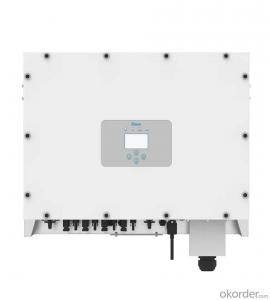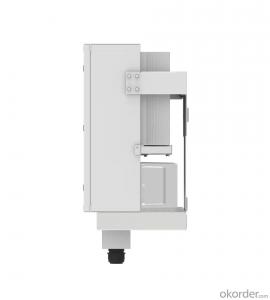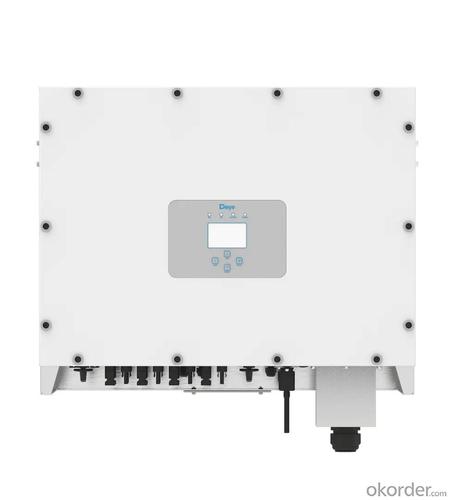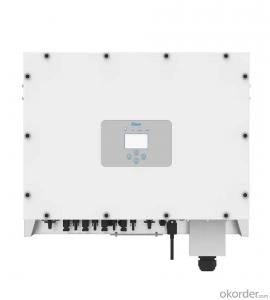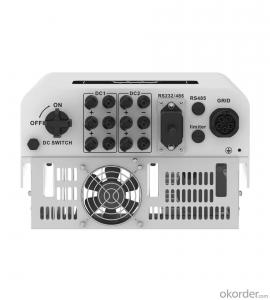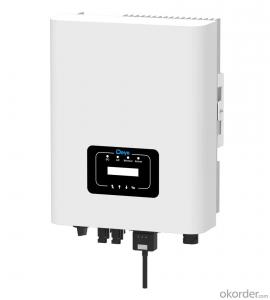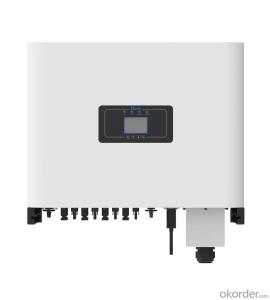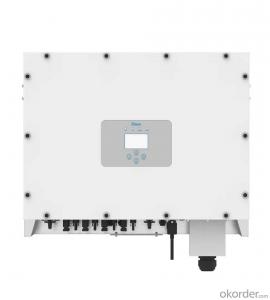Solar Inverter EMI Sun-35/40/45/50k-g-lv | 35-50kW | Three Phase | 4 MPPT | Low Voltage | 127/220VAC
- Loading Port:
- Ningbo
- Payment Terms:
- TT OR LC
- Min Order Qty:
- 100 pc
- Supply Capability:
- 5000 pc/month
OKorder Service Pledge
OKorder Financial Service
You Might Also Like
Specification
This series inverter is specially designed for 127/220Vac three-phase system, providing rated power at 35KW, 40KW, 45KW, 50KW. Equipped with large LCD and buttons, easy to operate and maintenance. With compact design and high-power density, this series supports 1.3 DC/AC ratio, saving device investment.
127/220Vac and 60Hz, three phase system
4 MPP tracker, Max. efficiency up to 98.7%
Zero export application, VSG application
String intelligent monitoring (optional)
Wide output voltage range
Type II DC/AC SPD
Anti-PID function (Optional)
| Technical Data | ||||||
| Model | SUN-35K-G02-LV | SUN-40K-G-LV | SUN-45K-G-LV | SUN-50K-G-LV | ||
| Input Side | ||||||
| Max. DC Input Power (kW) | 45.5 | 52 | 58.5 | 65 | ||
| Max. DC Input Voltage (V) | 800 | |||||
| Start-up DC Input Voltage (V) | 250 | |||||
| MPPT Operating Range (V) | 200~700 | |||||
| Max. DC Input Current (A) | 30+30+30+30 | 40+40+40+40 | ||||
| Max. Short Circuit Current (A) | 45+45+45+45 | 60+60+60+60 | ||||
| Number of MPPT / Strings per MPPT | 4/3 | 4/4 | ||||
| Output Side | ||||||
| Rated Output Power (kW) | 35 | 40 | 345 | 50 | ||
| Max. Active Power (kW) | 38.5 | 44 | 49.5 | 55 | ||
| Nominal Output Voltage / Range (V) | 3L/N/PE 127/0.85Un-1.1Un,220 /0.85Un-1.1Un (this may vary with grid standards) | |||||
| Rated Grid Frequency (Hz) | 60 / 50 (Optional) | |||||
| Operating Phase | Three phase | |||||
| Rated AC Grid Output Current (A) | 91.9 | 104.9 | 118.1 | 131.2 | ||
| Max. AC Output Current (A) | 101.1 | 115.5 | 129.9 | 144.4 | ||
| Output Power Factor | 0.8 leading to 0.8 lagging | |||||
| Grid Current THD | <3%< span=""> | |||||
| DC Injection Current (mA) | <0.5%< span=""> | |||||
| Grid Frequency Range | 57~62 | |||||
| Efficiency | ||||||
| Max. Efficiency | 98.7% | |||||
| Euro Efficiency | 98.3% | |||||
| MPPT Efficiency | >99% | |||||
| Protection | ||||||
| DC Reverse-Polarity Protection | Yes | |||||
| AC Short Circuit Protection | Yes | |||||
| AC Output Overcurrent Protection | Yes | |||||
| Output Overvoltage Protection | Yes | |||||
| Insulation Resistance Protection | Yes | |||||
| Ground Fault Monitoring | Yes | |||||
| Anti-islanding Protection | Yes | |||||
| Temperature Protection | Yes | |||||
| Integrated DC Switch | Yes | |||||
| Remote software upload | Yes | |||||
| Remote change of operating parameters | Yes | |||||
| Surge protection | DC Type II / AC Type II | |||||
| General Data | ||||||
| Size (mm) | 700W×575H×297D | |||||
| Weight (kg) | 60 | |||||
| Topology | Transformerless | |||||
| Internal Consumption | <1W (Night) | |||||
| Running Temperature | -25~65℃, >45℃ derating | |||||
| Ingress Protection | IP65 | |||||
| Noise Emission (Typical) | <55 dB | |||||
| Cooling Concept | Smart cooling | |||||
| Max. Operating Altitude Without Derating | 2000m | |||||
| Warranty | 5 years | |||||
| Grid Connection Standard | CEI 0-21, VDE-AR-N 4105, NRS 097, IEC 62116, IEC 61727, G99, G98, VDE 0126-1-1, RD 1699, C10-11 | |||||
| Operating Surroundings Humidity | 0-100% | |||||
| Safety EMC / Standard | IEC/EN 61000-6-1/2/3/4, IEC/EN 62109-1, IEC/EN 62109-2 | |||||
| Features | ||||||
| DC Connection AC Connection Display Interface | MC-4 mateable IP65 rated plug LCD 240 × 160 RS485/RS232/Wifi/LAN | |||||
| AC Connection | IP65 rated plug | |||||
| Display | LCD 240 × 160 | |||||
| Interface | RS485/RS232/Wifi/LAN | |||||
- Q: How does a solar inverter impact the payback period of a solar system?
- A solar inverter plays a crucial role in converting the direct current (DC) electricity generated by solar panels into usable alternating current (AC) electricity for household or grid consumption. The efficiency and performance of the solar inverter directly impact the overall energy production of the solar system. A higher quality and more efficient solar inverter can maximize the electricity generation, reducing the payback period of the solar system. Conversely, a low-quality or inefficient solar inverter may result in lower energy output, potentially extending the payback period of the solar system.
- Q: Can a solar inverter be used with different types of tracking systems?
- Yes, a solar inverter can be used with different types of tracking systems. The function of a solar inverter is to convert the DC (direct current) generated by the solar panels into AC (alternating current) that can be used to power electrical devices. As long as the tracking system is capable of generating DC power from the solar panels, the solar inverter can be used to convert it into usable AC power.
- Q: Are there any safety concerns associated with solar inverters?
- Yes, there are some safety concerns associated with solar inverters. One of the main concerns is the risk of electrical shock or fire due to faulty installation or maintenance. Additionally, there can be potential hazards from exposure to high voltage DC electricity during installation or repairs. It is important to follow proper installation procedures and adhere to safety guidelines to mitigate these risks.
- Q: What is the role of a power management system in a solar inverter?
- The role of a power management system in a solar inverter is to optimize the generation, distribution, and usage of solar power. It ensures efficient energy conversion, monitors the solar panel performance, manages the flow of electricity to and from the grid, and maximizes the overall system efficiency. Additionally, it may include features such as power factor correction, voltage regulation, and protection mechanisms to enhance the reliability and safety of the solar inverter.
- Q: Can a solar inverter be used with a three-phase power system?
- Yes, a solar inverter can be used with a three-phase power system. In fact, most modern solar inverters are designed to work with both single-phase and three-phase power systems.
- Q: Are there any ongoing maintenance requirements for a solar inverter?
- Yes, there are ongoing maintenance requirements for a solar inverter. Regular cleaning of the solar panels to remove dust and debris is necessary to maintain optimal performance. Additionally, inspections and tests of the inverter's components, such as cables and connections, should be conducted periodically to ensure everything is functioning properly. Monitoring the inverter's performance and addressing any issues promptly is also crucial for long-term maintenance.
- Q: What is the maximum DC input current that a solar inverter can handle?
- The maximum DC input current that a solar inverter can handle depends on the specific model and its design specifications. It can range from a few amps to several hundred amps, depending on the power capacity and intended usage of the inverter. It is important to consult the manufacturer's specifications to determine the exact maximum DC input current for a specific solar inverter.
- Q: What are the typical efficiency ranges for different types of solar inverters?
- The typical efficiency ranges for different types of solar inverters can vary depending on factors such as the technology used, the quality of the inverter, and the specific application. However, in general, string inverters typically have efficiency ranges of around 95% to 98%, while microinverters can achieve efficiencies ranging from 95% to 99%. On the other hand, central inverters, which are commonly used in large-scale solar installations, often have efficiency ranges of 97% to 99%. It's important to note that these are average ranges, and actual efficiency can vary depending on various factors and specific product specifications.
- Q: Can a solar inverter be used with different types of solar panel mounting systems?
- Yes, a solar inverter can be used with different types of solar panel mounting systems. The function of a solar inverter is to convert the direct current (DC) produced by solar panels into alternating current (AC) that can be used to power household appliances or fed into the grid. The compatibility of the inverter with different mounting systems depends on the electrical specifications and requirements of the panels and the inverter. As long as the electrical connections and voltage requirements are met, a solar inverter can be used with various types of solar panel mounting systems such as roof-mounted, ground-mounted, or pole-mounted systems.
- Q: What is the role of a solar inverter in a solar-powered desalination system?
- The role of a solar inverter in a solar-powered desalination system is to convert the direct current (DC) electricity generated by the solar panels into alternating current (AC) electricity that can be used to power the desalination process. The inverter ensures that the energy produced by the solar panels is compatible with the desalination system, allowing it to operate efficiently and effectively.
Send your message to us
Solar Inverter EMI Sun-35/40/45/50k-g-lv | 35-50kW | Three Phase | 4 MPPT | Low Voltage | 127/220VAC
- Loading Port:
- Ningbo
- Payment Terms:
- TT OR LC
- Min Order Qty:
- 100 pc
- Supply Capability:
- 5000 pc/month
OKorder Service Pledge
OKorder Financial Service
Similar products
Hot products
Hot Searches
Related keywords
